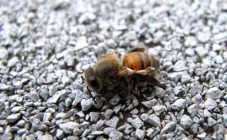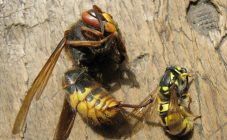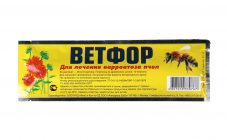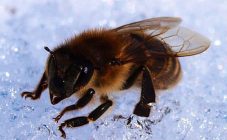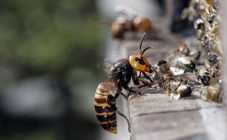Content:
In search of nectar, bees sit on melliferous plants. Various parasites can live on them. These include the bee mite. When infected with this parasite without prevention and timely treatment, in case of infection, the entire swarm may die.
Treatment of bees from ticks in the fall
The presence of a tick in the hive is evidenced by the behavior of striped insects and their appearance. Bees become more lethargic due to the loss of large amounts of protein and do not work as hard as usual. Young infected individuals may have underdeveloped wings or misshapen bodies. While the Varroa mite is easy enough to spot with the armed eye, the situation with the rest of the parasite is somewhat more complicated. To identify them, dead bees should be handed over to a laboratory for an appropriate study.
Practice shows that one dose is not enough to cure a swarm and provide high-quality prevention. Therefore, even as a preventive measure, beekeepers carry out treatment of bees from ticks in summer and autumn or spring and autumn.
The main routes of infection are as follows:
- bee theft;
- wandering bees;
- unification of families, one of which is infected;
- adding a frame with brood from a weaker family to a strong one;
- buying from an unreliable seller;
- old honeycomb frames.
Parasites prefer to live on a bee in the segments of the abdominal cavity. The mite lives there during the period of brood development: that is, from spring to autumn. What is especially surprising, despite the relatively small size of the insect, it can simultaneously contain up to 7 parasites.
Effective medicine
When choosing a medicine that can effectively cure bees from ticks, you should focus on the main active ingredient. There are only two of them: amitraz and fluvalinate. Experts recommend alternating one drug with another so that the tick cannot develop addiction. In recent years, many beekeepers prefer to use the combined type.
Despite the availability of pharmacological agents, some beekeepers continue to use old, but proven means of fighting bee mites. These are formic and oxalic acids and smoke treatments.
Use of formic acid
A remedy such as formic acid is a biological method for controlling ticks. The substance is diluted at a concentration of 85 to 87%. They act in the following way:
- About 40 ml of the drug is poured into a special unit.
- Hang it over the nest in the corner and wait for the formic acid to evaporate (this takes 3 to 5 days).
- Both entrance doors must be closed during processing.
Use of oxalic acid
Another popular method involves the use of oxalic acid. This method is the most common among beekeepers.This is due to the fact that in order to obtain the effect, the dose of formic acid is required more modest than that of formic acid. In order to get rid of mites, two grams of the composition is usually enough. The method of processing bees is identical to the previous one.
Smoke use
Alternatively, smoke the mites. To do this, the household must have such a device as a smoke gun. The procedure looks like this:
- hives are cleaned;
- canvas or rags are impregnated with propolis;
- the canvas is placed in a smoke cannon;
- treat the bee house.
Practice shows that smoke affects the tick very strongly. Within half an hour after the start of treatment, the parasites will begin to fall dead to the bottom of the hive.
Use of pine flour
The easiest and safest way to fight parasites involves the use of pine flour. It needs to be wrapped in gauze and just sprinkled with insects. No more than 50 grams of funds will be spent per family. In this case, getting rid of the tick occurs in less than a day. This is due to the fact that parasites do not like the smell of needles.
When to properly handle bees
To rid the bees of mites, you need to know what substances and devices to use and when it is more appropriate to process them.
Experts recommend performing the procedure in August and October. The indicated dates are chosen for the following reasons:
- After the removal of honey in the indicated months, the bee colony weakens significantly. Brood numbers are decreasing. As a result, the mite moves to adult bees.
- At the end of summer and in the autumn period of time, the temperature has not yet dropped to the point when the bees begin to greatly reduce their mobility. They move throughout the hive, as a result, the medicine is guaranteed to reach all corners of the bee house.
- Before winter begins, a tick-affected colony can leave the hive.
- Autumn is the period when bees are preparing for winter. The bees take it very hard, and if the family is infected, there is a high probability that it will die.
Drugs
Over the past thirty years, a large number of anti-tick drugs have been developed. Compositions such as Bipin, Amipol T and Vetfor have proven themselves especially well.
Bipin
The active ingredient in Bipia is amitraz. The composition is sold as an emulsion. It should be prepared exactly according to the manufacturer's instructions. The prepared solution cannot be stored for a long time - it should be used up immediately. Bipin is instilled into the hive using a medical syringe (a few drops between the frames are enough). Processing should be done twice. In this case, the time interval between procedures should be a week.
Amipol T
This drug is intended for the treatment of honey insects by contact. It is produced in the form of plates (wood or cardboard), the thickness of which is 1 cm. Each strip is impregnated with fluvalinate, which kills ticks in contact with it.
Vetfor
Vetfor is also a plate. The only active ingredient here is amitraz. It also contains fir oil and dimethyl sulfoxide.
Tool
The main tool that can be used to control ticks is the smoker. With its help, parasites are removed from the smoke. The base of the device is a cylindrical body equipped with a cone-shaped lid to which the bellows are attached. A metal glass with a lattice bottom is installed inside the case in some models. At the same time, there is a special space between the bottom of the glass and the body for ash. The glass is filled with materials for incineration and rags impregnated with a compound to kill mites.
Tick strips
Among the drugs for long-term installation in bee houses, plates for varroatosis are in high demand. They are often used as a preventive measure. An insecticide is applied to the plate, destructive for the parasite, but completely harmless for the bee colony. The devices are hung inside the hive. Bees, in contact with them, carry a poisonous composition throughout the hive. Plates are installed on average for a week, if there is sowing. If not, then the device can be kept for a month.
The main drawback that the tick strip has is the risk that the parasite may remain in the sowing. In addition, they are completely useless in the autumn, when the ambient temperature drops below +10 degrees. As you know, bees form a club in cold weather and try not to move too much.
When to install strips
There is no consensus on when to put tick strips in bee hives. Most beekeepers have two points of view: early August or mid September.
The option of installing devices after pumping honey in early August is considered to be classic. This time period is good because the beekeeper frees insects from the parasite in advance during the period of growing the family for the winter. In this case, the collection of strips does not take place in late mid-September, when the bees are still quite active. This means that they have a ton of opportunities to re-infection. And all the efforts made will be wasted. In addition, there is absolutely no guarantee that the parasite will not remain in the brood, and the procedure will not need to be repeated in October using a drug such as Bipin or its analogues.
Practice shows that it is easier to avoid any problem than to deal with its consequences later. Therefore, the health of bees throughout the year should be monitored with the utmost care, periodically carrying out prophylaxis.




